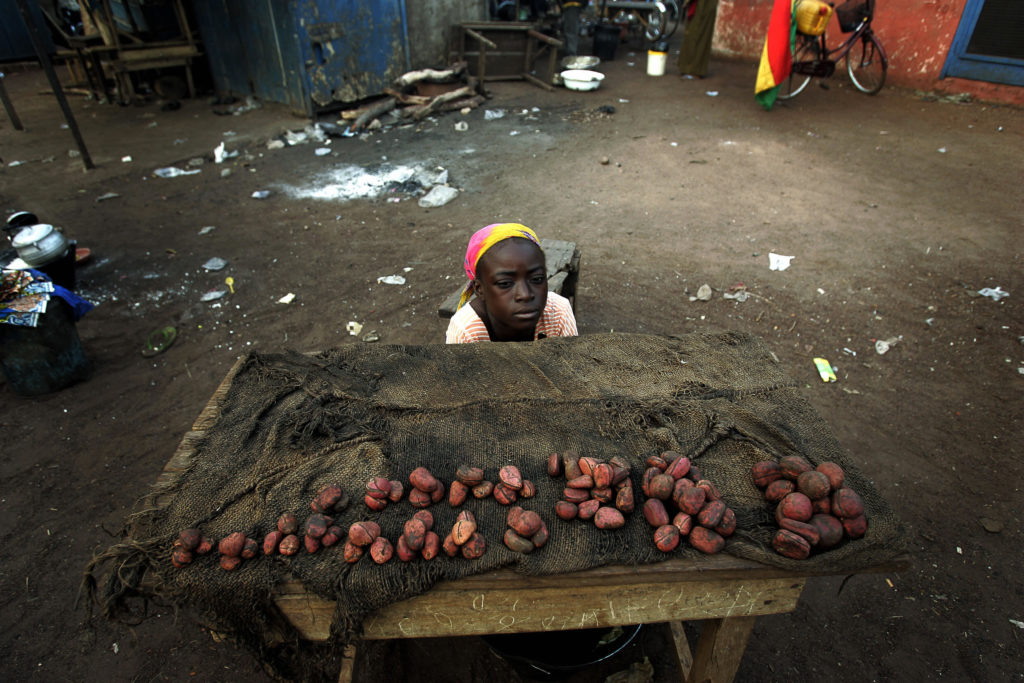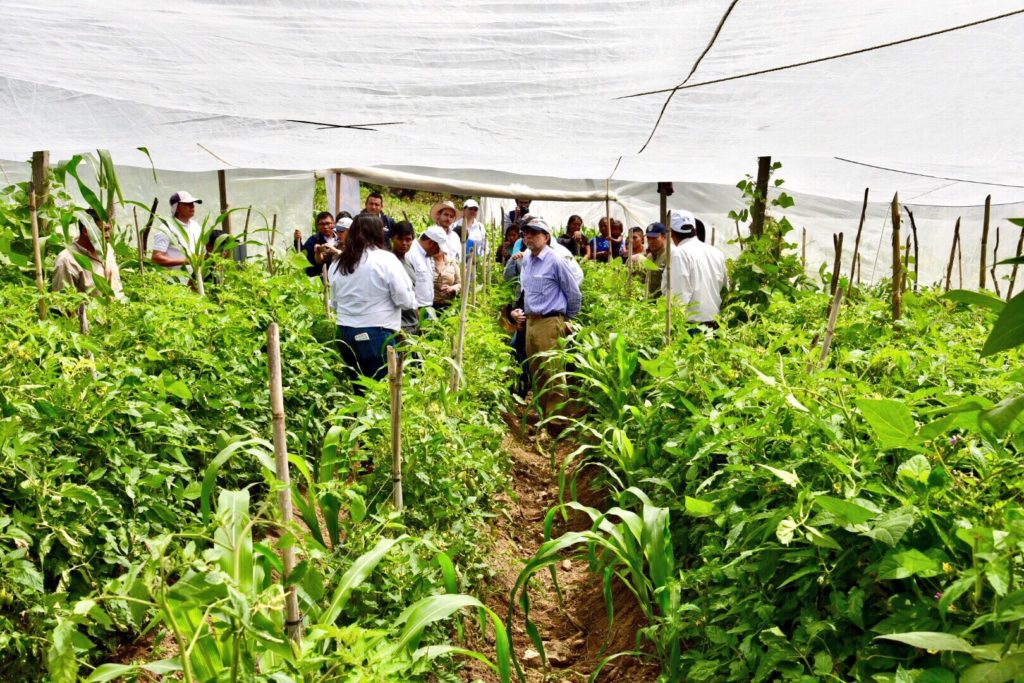While leaders from the Group of 20 nations renewed their vow to take action to curb climate change last month in Osaka, Japan, the United States became a lone dissenting voice, reiterating its decision to withdraw from the Paris Agreement.
“We have the cleanest water we have ever had. We have the cleanest air we’ve ever had, but I’m not willing to sacrifice the tremendous power of what we’ve built up over a long period of time and what I’ve enhanced and revived,” President Donald Trump said at a concluding news conference.
But while the Trump administration debates whether climate change is a true threat, alarms are sounding in the countries already home to some of the most vulnerable populations. Shifts in overall weather patterns are causing hotter temperatures, especially in equatorial regions of the world where many depend on the agricultural sector.
Hotter temperatures have led to increased water evaporation, drying out some areas, and increasing the number of storms in others.
For the hundreds of millions that depend on what they grow to feed their own families, the connection between climate change and food security is as direct as it is devastating.
Harvest Hardships
In Northern Ghana, agriculture has largely depended on the onset of its rainy season, where its staple crop thrives. However, in the past decade, the rainy season has shifted to begin later in the year, and farmable land has become much drier, resulting in increased crop failure.
Rainfall in the area is erratic. Ghanaian agriculture is primarily rain-fed, with very few developed irrigation systems, so changes in weather patterns heavily affect crop yield. Ghana’s northern region is particularly sensitive to changes in the climate because of hot, dry conditions and low-quality land. In the northern region, total crop failure is expected to occur approximately once every five years due to delayed or diminished rains.
“Food security is [when] all people at all times have access to safe, affordable, and nutritious food.”
KIMBERLY FLOWERS, DIRECTOR OF THE GLOBAL FOOD SECURITY PROJECT, CSIS
When these disruptions prevent populations from growing the food they need to feed themselves and their families, they risk becoming food insecure.
“Food security is [when] all people at all times have access to safe, affordable, and nutritious food,” explained Kimberly Flowers, the director of the Humanitarian Agenda and Global Food Security Project at the Center for Strategic and International Studies (CSIS). She noted that climate change has increasingly become a factor that threatens food security for many populations.
“When you look at how climate change has affected rising sea levels, rising temperatures, especially, the amount of too much or too little rain and how it affects a smallholder farmers lives, [food security] has directly impacted by climate change,” Flowers said.
Coffee Crisis
In the tropical slopes of Guatemala’s western highlands, climate change arrived in the form of orange and green spots on the leaves of the coffee plants.
Beginning in 2013, farmers began to notice what turned out to be the early signs of an outbreak of coffee rust. Within a short period of time, the outbreak destroyed 20 percent of coffee crops in Central America, leading to the loss of about 337,000 jobs and an estimate of $460 million in income for farmers who produced coffee within the region. This drove many farmers from their land to other towns and across the border to neighboring countries and beyond—including to destinations like the United States.
For Ghana, it means contending with the effects that climate change has on food security.
Guatemala is one of the world’s primary producers of coffee. The coffee industry makes up a big part of the country’s economy, accounting for 40 percent of all agricultural export revenue and employing about 30 percent of the country’s rural workforce.
The rust began to spread through Central America in the 1970s and 1980s. At first, the outbreaks were concentrated at lower elevations, but as temperatures in the region increased due to climate change, it was able to take hold even at the highest altitudes.
Small farmers are unable to replace coffee plants and are relocating elsewhere, in search of better economic opportunities.
CSIS’s Flowers has seen the difficulty of this transition firsthand.
“You see communities, you see families that are completely dependent on one crop, and it’s coffee,” Flowers said, “If you can’t make a living at something you’ve been doing for generations, what do you do when you don’t have the right resources to be able to grow what you know how to grow?”
Plans to Address Climate Change
Back in Ghana, the government has recognized the threat that climate change poses to its fragile agricultural system, but their efforts have been met with mixed success.
In 2015, the government released a “master plan” for addressing climate change. The plan promises a major mobilization of resources, including about $150 million for researching new innovations in sustainable food production.
But Nii Amanquah Addo, who focuses on environmental governance at the Ghanaian NGO Strategic Youth Network for Development, is concerned that these investments won’t be used efficiently.
“When it comes to the government, it is not responsive enough. Sometimes you have to go through the whole bureaucracy,” said Addo.
Ghana has made tremendous strides in improving food security in recent years. But there remains a dichotomy of results in the more rural northern regions of the country, where 90 percent of the population makes their living through agriculture.
According to the World Food Programme, while chronic malnutrition and stunting in children under age five has decreased in the country overall, it has slightly increased in the northern region. Sixty percent of children under five are anemic, while in the northern region, that figure rises to between 74 and 82 percent of children.

However, some programs are beginning to cut through the red tape and achieve real results.
Addo highlighted One District, One Factory, which aims to promote industrialization in the country’s agricultural sector. In the northern region, construction is 90 percent complete on a new processing factory for cassava, one of Ghana’s staple crops. If successful, this approach could both improve the region’s agricultural output and make it more resilient to climate shocks.
—
In order to continue to survive on their farms in Guatemala, smallholder farmers are also turning to climate-resilient crops.
One farmer, Rosita Juárez, has used her experience, training, and knowledge to create new disease-resistant and resilient crops.
Catholic Relief Services, in partnership with the U.S. Agency for International Development (USAID) and Guatemala’s National Association of Coffee Growers, trained Juarez and other female farmers to perform plant surgery. Juarez grafts rust-resistant coffee seedlings to prevent crop failure. She has taken leadership in a seedling production group of 15 families in her community, and together, they have created more than 45,000 resistant seedlings.
Funding these agricultural innovations is just one of the ways that USAID and other international organizations have helped to spur changes in places like Juárez’s village.
U.S. Policy Precautions
As droughts, floods, high temperatures, and other extreme weather phenomena continue to affect developing nations, the United States has taken a leading role in addressing issues of food insecurity through policy initiatives and partnerships with private sector actors. While this role and work tackle food insecurity, initiatives focused on climate change can lag behind.
Programs like Feed the Future uses a private-public sector approach to tackle the issue of food insecurity. Companies like Starbucks, Walmart, and Coca-Cola work with the U.S. government to expand access to nutritious food in 12 countries.

Feed the Future targets populations most in need and, in collaboration with local governments, creates action plans and policies to invigorate agricultural development and improve nutrition.
“Most presidents, when they come into office, have different initiatives they want to lead, and one of those might be around what’s your international development legacy. [President Obama] decided he wanted his to be food security,” said CSIS’s Flowers.
Funding these agricultural innovations is just one of the ways that USAID and other international organizations have helped to spur changes in places like Juárez’s village.
Feed the Future started their work in 2010 and has successfully managed to decrease cases of poverty and stunting by 23 percent and 32 percent respectfully in its 12 target countries. In Ghana, Feed the Future’s work has helped farmers earn over $40 million in new income.
Programs like The Agriculture Policy Support Project (APSP) have emphasized the intersection of the private sector and the Ghanaian government to create a more dynamic agricultural market in Ghana. In their efforts, APSP has created private sector friendly irrigation policy that will ensure year-round water supplies for farmers.
While the major objectives of Feed the Future are to accelerate agriculture sector growth and to improve the nutritional status of people in the targeted countries, climate change solutions are not explicitly explored in their strategy.
The next step in U.S. policy, the Global Food Security Act, seeks to create a “world free from hunger, malnutrition and extreme poverty.” Similar to Feed the Future, their main focus is on agricultural development and resilience to external shocks.
The Global Food Security Act, a congressionally controlled food security strategy budgeted until 2023, acknowledges the reality of climate change’s effects on smallholder farmers and introduces three methods of response: adaptation, absorption, and transformation.
Adaptation calls on a farmer to explore growing a different crop. Absorption entails introducing a new method of crop management in order to save a crop during a harsh growing season. Transformation calls on farmers to transition into the labor force as wage-based employees.
Both Feed the Future and the Global Food Security Act outline methods for curbing the issues of food insecurity through action by both governments and farmers. But in a far cry from the efforts of the Obama administration, the Trump administration has cast doubt on the future of these efforts to combat global food insecurity.
The Global Food Security Act, a congressionally controlled food security strategy budgeted until 2023, acknowledges the reality of climate change’s effects on smallholder farmers and introduces three methods of response: adaptation, absorption and transformation.
And as part of his battle with Central American countries over immigration, President Trump recently announced a nearly $500 million cut in aid to Guatemala, El Salvador, and Honduras.
By cutting off aid, the president would stifle key programs—like Feed the Future—which serve to relieve the countries from the very conditions that are causing climate refugees to migrate. The worsening conditions leave them with fewer options and increasing desperation.
“It certainly will affect Feed the Future,” said Julie Howard, an independent consultant on international development issues. “As far as I know, programs cannot go forward [in the Northern Triangle]—even the programs that would be very helpful in helping people continue farming there or adapt to climate change or give them an alternative to moving to cities.”
The advancing adverse effects of climate change on farmers have led to a decrease in economic opportunity and an increase in migration toward major cities in Guatemala, El Salvador, and Honduras. Within these cities, the influx of people has overtaken the availability of jobs; farmers are once again faced with the reality of a lack of opportunity. The next logical step is migration toward the United States.
Chase Sova, senior director of Public Policy and Research at World Food Program (WFP) USA, however, is hopeful that legislators have begun to take notice.
“Four out of every five people that the World Food Program helps in any given year are people who are living in places that are disproportionately going to be impacted from climate change,” Sova said. “So, while the problem seems very distant to us, there are things that can help it land here at home.”
He added that lawmakers are beginning to conceptualize climate change as a national security issue.
“Part of that narrative that has helped people to understand why this potentially distant threat of climate change impacts us, is this question of national security,” said Sova. “So increasingly you talk to people at Africom, and you talk to people at the Department of State and the Department of Defense, and they really care about this problem of climate change internationally, and the way that it’s affecting smallholder farmers around the world.”
New approaches outside of the government have also emerged.
In addition to aid from governments and NGOs, major agricultural companies have pitched in to help their suppliers confront climate change. World Coffee Research (WCR), which partners with Feed the Future, is funded by a variety of major coffee companies, including Peet’s and Green Mountain Coffee. The company has invested in finding new gene-resistant beans that can overcome hot seasons and troublesome diseases and insects.
WCR has worked closely with Starbucks to help 179 farmers in San Pedro Yepocapa, Guatemala, create and grow two rust-resistant varieties of coffee plants (Marsellesa and Centroamericano). Their work in the area also includes educating farmers on farming economics and wastewater management.
Sova is hopeful that the momentum exists to bring climate change solutions more into the global spotlight.
“There’s been a huge amount of research that has come out on the links between climate change and conflict, and climate change and instability . . . We’re starting to see increased investments in international food assistance programs; we’re starting to see increased investments in international global food security programs.”
“So, we know that by addressing some of these root causes of instability and migration, like food insecurity, that we can get ahead of this problem.”















